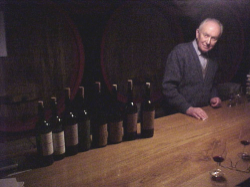Light on Your Feet

Alder arrived at our table to taste our barrel sample of 2010 Cornerstone Cellars, The Premiere Cornerstone about halfway through his grind. Taking a sip, he smiled, looked up and said, “light on its feet.” My heart almost lept out of my chest. He got it. He understood the wine.
Now understanding a wine may not seem like a big deal to you, but if you have ever stood in a room pouring wine to tasters whose palates have been hammered into submission by tasting dozens of wines before yours, you know what I mean. All to often tasters arrive at your table with the looks of a punch-drunk fighter their teeth and lips wine-bloodied by roundhouse punches from a room full of bloated heavyweights. In big tastings the Mike Tyson’s of the world get more attention than the Sugar Ray’s. The heavyweights are always the champs in these tasting marathons and wines with quick moves, balance and finesse are lost to palates pounded into submission by knockout punches of tannin and alcohol.
The wines of Cornerstone Cellars are crafted to be light on their feet. This does not mean light as in thin, but light as is deft and nimble; powerful wines that are under control and in balance. Wines that you can taste every nuance of from the first sniff to the long, lingering aftertaste. Make no mistake, our goal is still to knock you out, we just don’t want to knock you into oblivion. A knock out punch from Tyson or Sugar Ray will still put you on the deck.
Not far behind the “light on its feet” comment from Alder Yarrow came some equally encouraging and rewarding notes from other wine writers. Joe Roberts at 1WineDude said of our the 2010 Premiere Cornerstone, “a mid-palate to die for.” Meanwhile Fred Swan at NorCalWine noted the, “very long finish.”
To recap, three palates I respect (read no axe to grind) noted that the wine was, “light on its feet”, “a mid-palate to die for” and a “very long finish. In other words a complete wine from start to finish. “Completeness” is a concept to often ignored in a system that honors the first sip more than the last.
I think this is perhaps the essence of winemaking, that expression of your personal vision of completeness. For some, if not most, it is an expression of economic completeness, that is making a wine that sells and gets good reviews. For others, certainly the minority, to be complete means to make a personal expression even if it’s a harder sell, or, in the case of Premiere Napa Valley, not getting the mega-bids. On the other hand, wines made from commercial inspirations are always at the mercy of the critics, while those whose foundation is built on passion will find a loyal base of consumers that share their vision of what makes a wine meaningful.
Our Premiere Cornerstone lot at Premiere Napa Valley is the prototype for that vintage’s The Cornerstone, which is the expression of what our vision tells us is the pinnacle of Napa Valley winemaking. A sip of the Premiere Cornerstone is indeed a preview of what to expect in The Cornerstone itself. Our inaugural vintage of The Cornerstone, the 2009, will be released this September.
We could not be more proud of the how we have evolved the wines at Cornerstone Cellars into wines that offer a complete experience. There could be no better representation of this than our 2010 Premiere Cornerstone. It’s wine with a beginning, a middle and a long lingering ending: a complete wine. It will knock you out.















